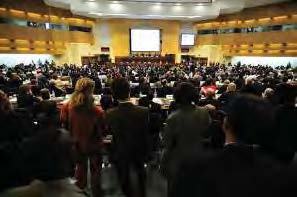By : Ann Harman
Well, you did it! You volunteered to be Meeting Chairman. Now what? It all depends on whether your club is the State Association or a County or Local group. Some parts of the planning are the same, but some are totally different. One of the differences is when to start planning. State meetings could really use up to two years in advance for plans, while a small local meeting could use several months. All too often the small local clubs succumb to panic – “Who can we get to speak next month?”
Let’s start with the local club, a somewhat simpler plan than a larger state meeting. How many times a year does the local club actually meet? The week of the month as well as the day of the week do influence how many meetings a club will have. Traditional events, such as a Christmas party or a Field Day need to be considered.
Keeping records can be a big help in planning. It is always possible to change what the club has always done. If the Christmas party had 45 people five years ago but only 16 last year, perhaps that event should be dropped or changed. Meeting planning should involve the whole club. Ask the members! Send out a survey. Some cannot attend every meeting throughout the year but they do know what sorts of activities would be of interest.
Keeping records also helps in choosing speakers. Looking back through several years you see that Beekeeper Burt has spoken every year – on the same topic. Perhaps it is time to give him a rest for a year or two. Attendance was low at his last two talks. Don’t be afraid to ask the members if anyone has a specialty they could present. Some people just do not volunteer but are happy to be asked. It’s worth a try. Someone may be making mead, doing things with wax, having success and failure with bee plants. At a meeting have the members jot down one (maximum two) topics they would like. Make no promises since speakers have to be found either in the club or in nearby ones.
Reach out to surrounding local clubs and ask about their program topics and speakers. Better yet, exchange electronic newsletters with as many groups as possible! If one of their members lives within reasonable driving distance you just may have acquired a speaker your club has never heard before. By the way, does the club’s treasury have enough funds to at least pay mileage and perhaps a small honorarium? The Meeting Planner should always be in touch with the club’s treasurer.
Another way of saying thanks to a speaker from a distance away is for the officers to take the speaker to dinner before the meeting. If a good speaker with an interesting topic does not want to drive at night, is there one of your members who lives close enough to provide transportation? A Meeting Planner needs to “think outside the box” to liven up the year’s programs.
Does your state have a state apiarist and regional inspectors? With all the new information appearing about mites, diseases and treatments, having a presentation on bee health is important. Inspectors can be busy so ask when a talk would be most suitable.
Business meetings, with election of officers, must be done according to the club’s Bylaws. Sometimes the business meetings involve some serious items such as revision of Bylaws. Most beekeepers consider these as uninteresting or even boring. Pay special attention to these meetings. Arrange for some door prizes. Throughout the year collect items and have a silent auction or a Chinese auction. Make it a party with members bringing cookies and cakes. It could even be a cookery contest with a nice prize. Promise the members that the business will be short but emphasize the importance.
During the Summer months many clubs will have a picnic or a Field Day at someone’s apiary. Be sure to check your insurance to avoid a surprise if an accident occurs. these events are part of your club’s activities is attendance still reflecting the enthusiasm for them? The membership of clubs changes over the years. New beekeepers appear and others leave. What worked five years ago may not work now. The weather for outdoor activities needs to be considered in planning for them.
It can be difficult for local clubs to have a meeting place that has equipment for speakers, such as for showing Power Point presentations or even a speaker system for a very large room. Sometimes laptops and projectors can be borrowed or brought by a member. What is essential is asking the speaker, well ahead of the meeting, what is needed. If the presentation is a demonstration are there some tables suitable for it? If there is a time limit on the available meeting room the speaker should be made aware of it so that the time for the presentation and any question session can be completed without having to ask the speaker to hurry up or to stop before finishing.
State beekeeper meetings are somewhat similar to local club meetings but actually involve much more advance planning. Sometimes one of an officer’s duties is to be Meeting Planner. No matter how chosen, it could help to have an assistant to take care of some of the details. And there are many more items to consider to make the meeting a success. So let’s start considering those details to see why it could take up to two years to make plans.
Some states have one main meeting a year, others may have two. Or one formal meeting and another like a field day. The meeting locations tend to move throughout the state to attract attendance from the local clubs of the area. Are the meetings one-day or two days? Or a Friday afternoon and all day Saturday? Do the days need changing? Here again, records of past attendance will help in planning.
At every state meeting have a Suggestion Box visible and supplied with some paper and pens. Also make a survey sheet that is handed to attendees. Encourage everyone to take advantage of both, reminding all that it is their association and information is welcome. But make no promises.
One reason for advance planning is the availability of a venue. Hotels with meeting rooms and conference centers, community colleges, universities, all tend to have meetings scheduled one or even two years in advance. Many of these venues have conference planners to help you select meeting areas and costs. If you find one that is suitable, make reservations!
What makes a venue suitable for a state meeting? Lots of questions arise – do the answers make it suitable? Main auditorium – how many people, breakout rooms for workshops, speaker-friendly auditorium and also breakout rooms, allowed to put signs up outside and inside to guide attendees, facilities for lunch, parking for cars and vendor trucks, suitable space for vendors, area for registration, area for special events such as a honey show. True, no venue may be perfect. However try to choose the one with the smallest number of problems. With two years until the meeting it is possible to select a good venue reasonably close to the desired area.
Another reason for a two-year time frame is availability of speakers. Your members want to hear “the famous ones.” They may be university or government researchers or are known to give fantastic presentations. These people are busy! They are in demand! Actually the researchers have work to do and cannot find the time to travel to too many meetings. If you ask well in advance you may be successful in having that speaker that everyone wants to hear.
At some point the program needs to be planned. A general plan is to have registration at the beginning of the day, some opening remarks, speakers, break time, speakers, lunch, afternoon speakers or breakouts, break time, speakers or breakouts, end of day. Let’s look at two problems: one where timing can be a problem and one that every speaker dreads.
In general the first day of a big meeting starts with a short welcome and any important announcements. This is followed by the first speaker, usually one of the “famous ones.” This speaker has been allotted 45 minutes maximum for presentation including questions. So that is what the speaker has planned. However, what if the person giving the short welcome and announcements rambles on and on, well over the allotted time. Now the first speaker has a problem to keep the meeting running on time: discard the question time and perhaps rush through some parts of the presentation. Keeping the meeting on time is not the responsibility of the speaker but is on one of the officers or the meeting planner. If there are so many announcements some can probably wait until after break time. Running on time is essential to a good meeting.
What does every speaker dread? Being the “after lunch” speaker. Box lunches are a good way to do a meeting lunch. They keep people at the meeting venue so that the afternoon session can start on time with the audience present. If lunch is “on your own” it means most will leave the venue to find lunch at a suitable place. Unfortunately beekeepers like to talk to their friends so that many do not return to hear the speaker or they return and find their seats during the talk. With the box lunch, everyone may attend the presentation and some will promptly fall asleep. Assorted musical snores are scattered throughout the audience. Right after lunch is the best time to have small breakouts that can include workshops or some activities, not a formal talk.
The Meeting Planner is responsible for calculating the expenses – speaker costs, such as transportation, meals, hotel, honorarium. Therefore, working closely with the Treasurer is essential. Finding helpers is also important. Transportation for the speakers who are flying to and from the meeting needs to be arranged and should definitely be on the list of “Speaker Care” items. Also, making sure speakers have access to a restaurant before or after the meeting is critical. A club member can be asked to make those arrangements.
Having a Vendor Coordinator means that the vendors, large and small, have suitable spaces and that their respective spaces are clearly labeled. Some venues will have facilities for vendors to unload their supplies and also to park trucks and trailers. Giving the vendors information on facilities in advance makes their tasks easier.
Now that all the details have been covered, it is time to let members know about the meeting and the speakers they have been waiting to hear. The state association may have a newsletter or a journal. How often is it published? Actually, does anyone read it? If it comes via snail mail it will get set aside “to read later” and get buried under other “read laters.” Via email it may come at a suitable time. But did that email actually get read or did it join the “read laters?” Short email reminders – especially featuring the “famous speaker” are important.
Was the website updated with glowing details of the meeting? You can reach people on Facebook all the time today. Make use of it. Send out Tweets, each one naming a different scheduled presentation or workshop. These two tactics may well reach more people than visit the webpage or read email notices. Make use of all the available ways to reach people today. Your speakers will be impressed with the enthusiastic attendance.
It’s February – time to get busy for planning a meeting!











